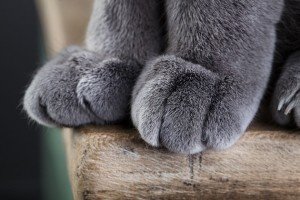 Stock Image - cat paws
Stock Image - cat pawsDunbarton resident suspects her cat had been tortured by community members as retribution for its hunting habits. Now, she hopes the perpetrators will be brought to justice.
A woman who lives on Rutherglen Place in Dunbarton was surprised to return home the evening of Aug. 20 and not find her indoor/outdoor cat, MizzyT, on her front porch. A bad storm had just blown through the neighborhood, and MizzyT always returned home in bad weather.
MizzyT is a female cat of the gray and white tuxedo variety. She is 17-years-old and approximately seven pounds. MizzyT used to spend much of the day exploring the neighborhood. Although she is spayed and microchipped, her owner does not like her to wear a collar a cat she owned was once injured by one.
When MizzyT was not on the porch that evening, her owner called for her. Mizzy then came home in a pathetic state, bleeding from her paws and drenched from the rain.
The owner noticed the blood, and upon further inspection saw that MizzyT’s claws had been removed.
“ cut them to the quick, pulled all of her nails out front and back. Most of them won’t be able to grow back,” MizzyT's owner said.
The woman wondered who could have done this. The cat had no other injuries: scratches or bites that would have indicated a fight with another animal.
Mizzy’s owner took her to her local vet who told her the paws look as though they had been declawed with pliers or a blunt object. The declawing looked to have been done by a person without any veterinary knowledge.
The resident asked around to find who could have done this to her beloved pet. She received one piece of useful information from a woman who often walks dogs. That woman told her that she had seen people from the neighborhood feeding the cat. Those people said MizzyT is on a “hit list” because she was one of the cats that had killed local songbirds.
MizzyT is a hunter by nature. She is a rescue who is half-feral cat and part domestic. It was always in her nature to take down birds and rabbits.
MizzyT's owner along with her veterinarian decided to contact the police, and the Prince William Police Department has opened an investigation into the incident.
According Virginia statute 3.1-796.122 Cruelty to Animals, the suspected crime may be categorized as a Class 1 misdemeanor. If the accused has any prior convictions of animal cruelty, it could become Class 6 felony.
The animal has also sustained a trauma.
According to Dr. Brenna Stapleton at Artemis Veterinary Animal Emergency & Specialty Services Hospital, a declawing performed by a non-professional would be terribly painful for an animal.
“Unfortunately even in the hands of a trained professional a declaw can be an uncomfortable procedure. For this reason, cats are fully anesthetized and given pain medications. A non-professional does not have access to the equipment or medications needed to ensure adequate pain control," Stapleton said.
Other concerns, she said, include the risk of infection.
“A true declaw does not simply consist of removing the nail from the nail bed, but is instead an amputation in which the most distal aspect of the cat's toe is removed in order to prevent regrowth of the nail. This is equivalent to removing a person's fingertip at the last knuckle. If the underlying bone is exposed, there is a risk that the cat could develop osteomyelitis (bone infection) which can be very difficult to treat.”
Dr. Stapleton has never treated a cat that had a non-professional declawing done. She said declawing are even controversial when performed by a vet.
“Most people declaw their cats to prevent them from scratching people or furniture. Scratching, however, is a natural behavior in which cats keep their nails healthy, mark territory, stretch and get exercise. Declawing is not necessarily a quick fix for unwanted scratching and carries significant risk ranging from pain or complication with surgery to unwanted behavioral changes after surgery,” she said.
Additionally, once declawed, a cat should stay inside for its protection.
“A declawed cat should be kept indoors as we have removed one of it's most important tools to defend itself from predators,” Stapleton said.
Meanwhile, MizzyT’s owner believes her cats spirits are down because she is not allowed to go outside.
Anyone with information about how the cat was hurt should contact Prince William County Police.
Support Bristow Beat - Donate Today!